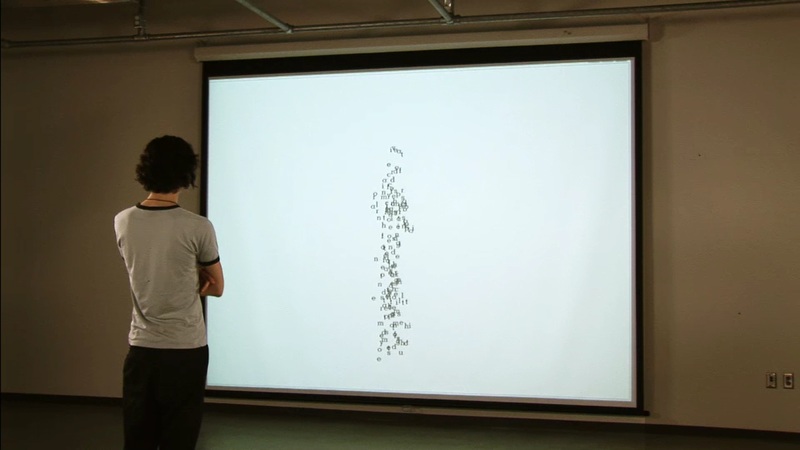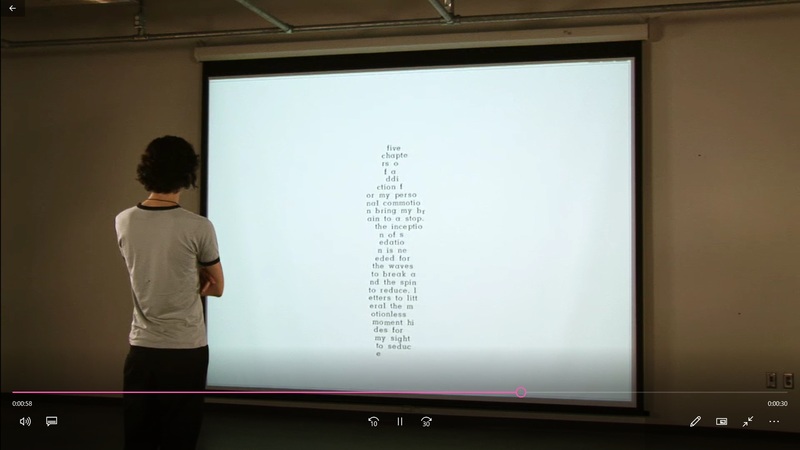-
Titre
-
Still Standing
-
Créateur
-
Bruno Nadeau
-
Jason E. Lewis
-
Date de création
-
2005
-
Date de validité
-
2005-2005
-
Langue
-
Anglais
-
Résumé
-
Still Standing est une œuvre poétique affichée sur grand écran qui réagit aux mouvements du lecteur. En effet, le poème est d'abord présenté comme un amas de lettres au bas de l'écran devant lequel le lecteur marche. Chaque mouvement fait réagir les lettres et les pousse comme si elles faisaient des sauts. Lorsque le lecteur arrête de bouger et se tient immobile, alors les lettres vont graduellement monter l'écran et se placer en imitant la silhouette du lecteur. C'est ainsi, en restant immobile, que ce denier pourra lire le poème devenu compréhensible.
-
Description
-
« Like Camille Utterback's Text Rain and other interactive installations in its genre, Still Standing invites participants to use their bodies as reading instruments. In order to read the poetic content of Nadeau and Lewis's installation, that is, the viewer must remain perfectly still, her stillness causing the video-projected text to assemble as if attracted to a magnet. The structure of the work, along with its poetic content, might seem to suggest that reading requires cognitive rather than bodily engagement, that stillness is a necessary prerequisite. But the activity of standing still requires rigorous muscular control, such that Still Standing serves to remind us that reading is a fundamentally embodied activity.
Author description: Still Standing was produced in collaboration with Jason E. Lewis. It is an interactive installation that invites participants to stay motionless and contemplate its poetic content, a poem titled "seeking sedation". Nowadays, designs are created to be decrypted and enjoyed at a glance, requiring no attention span. The piece evolved as a response to the "collapse of the interval"; a phenomenon of fast pace culture that rarely allows us a moment to stop and observe; a habit that weakens the fragile approach towards design with dynamic typography. The installation consists of an amalgam of characters projected on the wall as if they were resting on the floor. When a participant walks in front of the projection, the first reaction of the text is to act as if it was being kicked, pushed by the person's feet. When the participant stops for a short moment, the text is attracted towards his position and moves up, like water soaking his body. The participant can then enjoy a motionless moment and contemplate the textual content that becomes more and more legible. When the user is done and decides to start moving again, the text falls back to the floor and wait for a new interaction. »
Mention de genre autodéclarée : « interactive installation »
-
L'exposition est présentée dans le cadre d'inter-inactivity, DAC 2005, Copenhague, Danemark
-
Thèmes
-
Immobilité
-
Lecture
-
Médias modernes
-
Réception et sources
-
Leonardo Flores pour I Love E-Poetry, « “Still Standing” by Bruno Nadeau and Jason Edward Lewis », publié le 25 février 2012.
-
« Still Standing » pour Taylor English Literature, publié le 4 novembre 2014.
-
Laura Sánchez Gómez, « Poéticas Digitales: el texto como imagen de una obra cinética », pour Janus, Anexo 1 (2014), Humanidades digitales: desafíos, logros y perspectivas de futuro, p. 423-435.
-
Jason E. Lewis et Bruno Nadeau, « Inter-activity », pour ObxLabs.
-
Roberto Simanowski, « Event and Meaning. Reading Interactive Installations in the Light of Art History », Bereitgestellt von | Universitaetsbibliothek Basel Angemeldet Heruntergeladen am | 09.10.18, p. 137-150.
-
Francisco J. Ricardo, « Literary Art in Digital Performance: Case Studies in New Media Art and Criticism », Bloomsbury Publishing USA, 26 nov. 2009, 200 p. Voir p. 29.
-
Mentionnné dans l'article « The Struggle to Define a Position: What will be the Future of Electronic Literature? » de Janneke Adema pour Open Reflections, publié le 21 juillet 2010.
-
Matthias Hillner, pour l'International Council of Design, « VIRTUAL TYPOGRAPHY - A NEW APPROACH TO MOTION GRAPHICS? », publié le 22 avril 2009
-
NT2
-
Electronic literature collection
-
ELMCIP
-
MIT Libraries
-
CELL
-
Site créé pour décrire l'œuvre et la démarche.
-
A. Spangle, « Still Standing/Text Rain », pour Electronic Literature ENGL 376VV. A literature course at the University of Mary Washington, publié le 13 mars 2012.
-
Cjon2 pour Digital Rhetoric and New Media (ENGH 376/508, automne 2012), publié le 25 septembre 2012.
-
Joseph Tabbi, « The Bloomsbury Handbook of Electronic Literature », Bloomsbury Publishing, 30 nov. 2017, 464 p. Voir p. 328-330.
-
Roberto Simanowski, « Digital Art and Meaning: Reading Kinetic Poetry, Text Machines, Mapping Art, and Interactive Installations », U of Minnesota Press, 2011, 291 p. Voir les p. 49-53.
-
Personne ayant créé la fiche
-
Aude Meunier-Rochon






